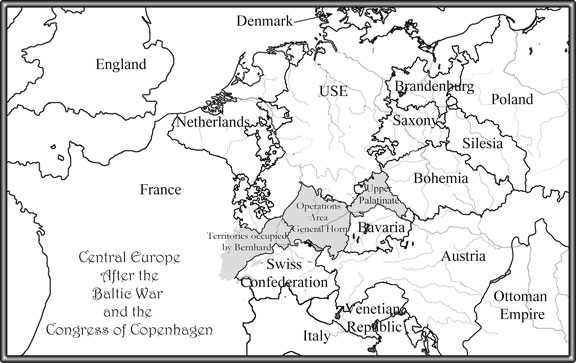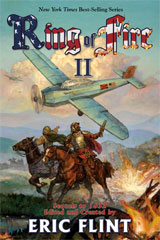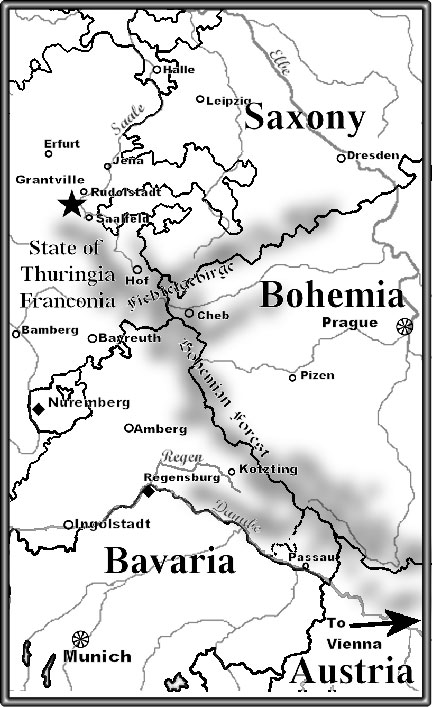

This is the second of the Ring of Fire anthologies, following the one that came out four years ago, in January of 2004. As was the case with the original Ring of Fire, the stories in this anthology are all part of the 1632 series which I began in 2000 with the founding novel, 1632, and have since continued with the following novels:
1633
1634: The Baltic War
1634: The Galileo Affair
1634: The Bavarian Crisis
1634: The Ram Rebellion
1635: The Cannon Law
In addition to the six novels so far published in the series and the two Ring of Fire anthologies, other stories in the 1632 setting have been published in the part-anthology/part-novel titled 1634: The Ram Rebellion, as well as the Grantville Gazette. The Gazette is an electronic magazine devoted to the 1632 series which I began publishing in 2003, the sixteenth issue of which has just come out. Beginning in the summer of last year, the Gazette is published on a regular bi-monthly basis. The first three volumes of the magazine were published by Baen Books in a paper edition, and the fourth volume is coming out in paper in June of this year.
(For information on how to subscribe to the Gazette, see the end of this preface.)
To put it another way, short fiction is as integral a part of this series as novel length stories. "Integral," not simply in the sense that the stories are part of the setting, but that they often play a major role in shaping the series. They are not simply, as is usually the case with spin-off anthologies attached to a popular series, stories "off to the side." What happens in these stories very often lays the basis for major developments in the novels, as well as either introducing important characters or developing them still further.
That's especially true of the stories which appear in the Ring of Fire anthologies. There is no sharp and clear dividing line between stories that appear in the Gazette and stories that appear in the RoF anthologies. The distinction is certainly not one of literary quality in the abstract. But, as much as possible, I try to select stories for the Ring of Fire anthologies which connect more directly with the series as a whole than do most of the stories in the Gazette.
That was true for the first Ring of Fire anthology, as I explained in some detail in my preface to that volume. It is true of this second one, as well. To give some examples:
Andrew Dennis' "Lucky at Cards" is an integral part of the story line which he and I began in 1634: The Galileo Affair, developed further in 1635: The Cannon Law, and will be continuing in novels to come. It depicts an episode in the career of Giulio Mazarini—now Jules Mazarin, having taking service with Cardinal Richelieu's France.
Gorg Huff and Paula Goodlett's "A Trip to Amsterdam," along with Iver Cooper's "The Chase," develop further the adventures of a group of young American entrepreneurs whose story was begun by Gorg as far back as the first volume of the Gazette (see "The Sewing Circle") and has continued in a number of stories published in later issues of the magazine. So far, those characters and their activities have only received incidental mention in the novels, but that will be changing in the future. These kids are not about to go away, to say the least.
David Carrico's "Command Performance" is one of several stories he's written, the first of which appeared in the Gazette, that depicts the impact of the time-transplanted Americans on seventeenth-century music and musicians. These same characters will figure prominently in a murder mystery novel he and I co-authoring titled 1635: Symphony for the Devil.
K.D. Wentworth's "Eddie and the King's Daughter" tells the story of how the romance between Eddie Cantrell and the Danish king's daughter Anne Cathrine, which figured prominently in 1634: The Baltic War, got started in the first place.
Virginia's DeMarce's "Second Thoughts" continues the story of Noelle Murphy, one of the central characters in 1634: The Ram Rebellion, and serves as a preface to the final story in this anthology.
That's my own short novel, "The Austro-Hungarian Connection," which ties the development of Noelle as a character to major changes taking place in political and military developments in Austria and Hungary with the accession to the throne of a new emperor. The story also features Denise Beasley, one of the major characters in a new novel I've co-authored with Virginia entitled 1635: The Dreeson Incident, which is coming out in September of this year.
And this preface is probably long enough. I hope you enjoy the book.
Eric Flint
July, 2007
Those of you interested in subscribing to the Grantville Gazette can find it at the following URL: http://www.grantvillegazette.com.

